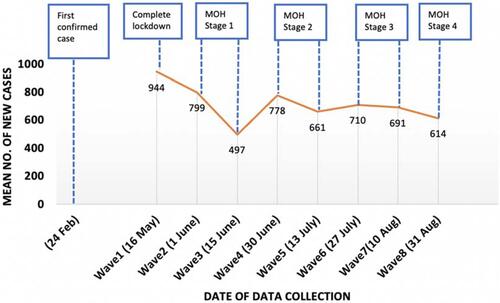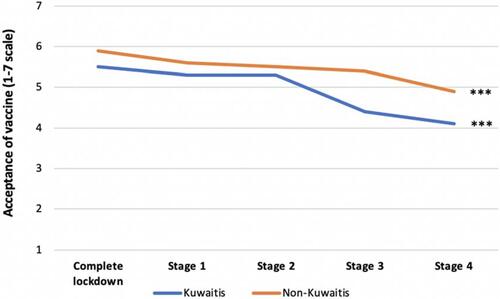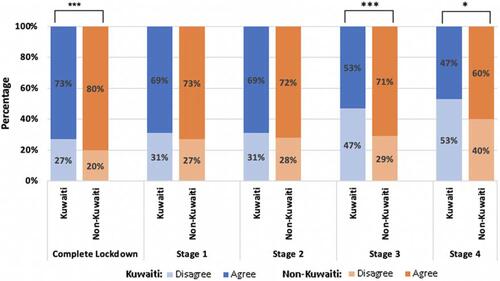Figures & data
Table 1 Participant Characteristics and the Association with Agreement Towards Taking the COVID-19 Vaccination, Kuwait, May–Aug, 2020
Table 2 Association Between Knowledge, Risk Perceptions, Preparedness and Perceived Self-Efficacy, Precautionary Measures, Information and Trust, Policies, Panic Behaviours and Fear, and the Seasonal Influenza on Agreement Towards Taking the COVID-19 Vaccination, Kuwait, May–Aug, 2020
Figure 1 National epidemic trend of new COVID-19 cases and political situation in Kuwait, May–August 2020.
Notes: Complete lockdown, closure of the entire country's facilities and institutions, with exception to supermarkets, and full curfew with a maximum of 2 hours per day for exercise; Ministry of Health (MOH) stage 1 of the government's restoration to normality plan, with partial curfew from 6:00 p.m. to 6:00 a.m., and some reopening of industrial activities, public services, and home delivery for restaurants and retail shops; MOH Stage 2, with partial curfew from 8:00 p.m. to 6:00 a.m., and further openings including workplaces (less than 30%), finance and banking, commercial complexes, retail shops, restaurants (take away only), gardens and public parks; MOH Stage 3, with partial curfew from 9:00 p.m. to 05:00 a.m., and opening of workplaces (less than 50%), social welfare home visits, hotels, resorts, and hotel apartments, taxis, mosques to allow group Friday prayers; MOH Stage 4, with no curfew, and opening of workplace (more than 50%), restaurants and cafes (with social distancing), public transportations, personal care shops (salons, shaving, spa), and public and private sports courts.

Figure 2 The mean level of acceptance to taking the COVID-19 vaccine if it becomes available and recommended, by nationality (Kuwaiti, non-Kuwaiti), during the Ministry of Health’s “Return to Normality” stages, Kuwait, May–Aug 2020.

Figure 3 The proportion of agreement and disagreement towards taking the COVID-19 vaccine across the Ministry’s “Return to normality” stages, by nationality (Kuwaiti, non-Kuwaiti), Kuwait, May–Aug 2020.

Table 3 Multivariable analysis: Factors Related to Increased Agreement Towards Taking the COVID Vaccine, by Nationality (Kuwaiti/Non-Kuwaiti), Kuwait, May–September, 2020
